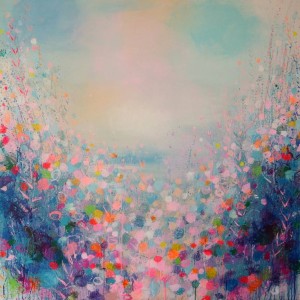Inside the Studio
 Sandy Dooley
Sandy Dooley
Favorite materials to work with?
Primarily acrylic paint and canvas. I work in thin watercolor-like layers, slowly adding color and intensity to the canvas, as well as adding medium to the paint to create texture or gloss. This flexibility is integral to the way I work as it allows me to build up a large range of marks and textures.
How many years as an artist?
Ever since I can remember.
Where is your studio?
In my garden. It’s very modest and I almost always work outside.
What themes do you pursue?
I have always enjoyed exploring the line between abstraction and figuration. I live in rural Kent in South-East England, and love the countryside I am surrounded by. My environment seeps into my paintings. My palette and subject matter are colored by the passing seasons. I try to convey light in painting. I almost always work outside and find natural light hugely inspiring.
Paint and marking making themselves are often starting points. I work quite fast initially, building up colours and tones in a pretty free way. Spontaneity is important. I have developed a practice of dripping and flicking paint as it often leads to intriguing combinations of mark and colour. It can go badly, and I have a high disaster rate! Some of my most satisfying paintings are on canvasses which have two or three paintings underneath. The texture and colours are multilayered and rich.
Color, or rather combinations of colors, keep me painting. I love having lots of paint, lots of colour available. One idea can just lead to another for me when I am working, and the trigger is often seeing three or four colours grouped together on a canvas. My palettes are things I love to look at. I have three or four plates or shallow bowls on the go at once, and looking at yesterday’s paint layered on my palette is a good way into the day.
Spending time just looking at work, usually at the end of a painting session is also valuable. Thoughts and ideas often lie semi-formed until the following day. The first five minutes in my studio are very significant. I often suddenly see something that immediately needs changing. That fresh critical eye is a great way to start painting.
Prefer to work with music or in silence?
It has to be silence. I can’t focus when there is music on.
Where can we find you outside the studio?
Cinema is something I love, and we have a wonderful cinema just five minutes away from our home. Getting out on my road bike is also fun. Spending hours alone every day means I love to socialize. Getting together with friends to have a laugh is definitely on the agenda.
What’s around the corner from your place?
Fields, houses, and a farm. I often have a quick walk or jog to wake my eyes and brain up first thing in the morning. My local town is five minutes by car.
What was the best advice given to you as an artist?
Work a lot! The more experience you can gain in handling materials, the larger vocabulary you have at your disposal. A tutor at college told me this, and as I have got older it resonates more and more. Taking care of the practical side of painting by building skills and techniques with materials, gives space and confidence for experimentation and ideas to flow.
Art school or self-taught?
Art school. I spent four years at St Martin’s School of Art in Central London. Great college, great location!
If you couldn’t be an artist, what would you do?
Good question! I find applied arts fascinating, textile designer please.
Day job?
Luckily I have been able to spend a lot of time painting on top of helping my partner in his business.
What do you collect?
I enjoy looking at other artists’ work and have a small collection of art. I find Pembrokeshire in Wales a beautiful, soulful place where I have spent a lot of time over the years. Welsh blankets and quilts draw me. The history around quilt making, the fabrics which are used and the beauty and utility of the quilts themselves all fascinate me. I have a weakness for bowls; my kitchen cupboards are groaning under the weight of them as I try and find the elusive perfect breakfast bowl.
Favorite contemporary artist?
I like a range of contemporary art, and the Internet has made looking at otherwise inaccessible paintings possible. It’s hard to pick one and categorically call it my favorite. English artist Andrew Gifford paints sumptuous cityscapes. I saw some very large works depicting Istanbul that have stayed with me. Online, I have looked at Australian Todd Hunter’s work and loved it. At the moment American artist Madelaine Denaro is one of my favorites, as well as Australian landscape artist Joanna Logue.
Is painting dead?
No, I believe it’s a powerful human impulse to record the world around us.
Use anything other than paint?
I make a lot of drawings and paintings on watercolor paper which are a source of ideas for me. They are more figurative that my paintings on canvas. I use lots of different materials here: charcoal, compressed charcoal, gouache paint, oil pastels, inks and pencil. Using these together help to quickly build texture and intensity on the paper.
Palette knives?
Yes, lots. I probably use them 50% of the time when painting. I often have a paintbrush in one hand, and a palette knife in the other, ready swap around at any moment. They are also handy for mixing paint and extracting it from pots.
Monet or Manet?
It has to be Monet, his work is such a source of inspiration for me.


















